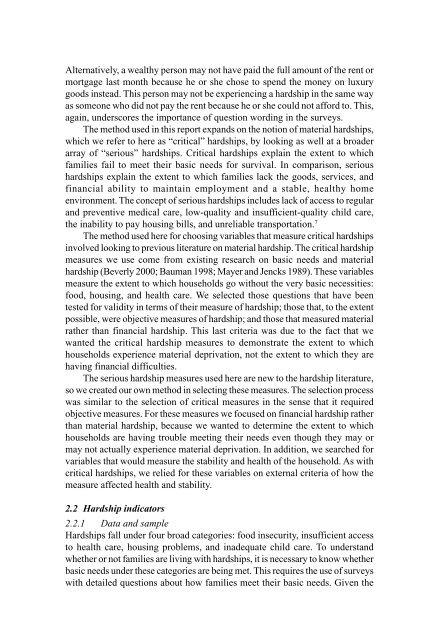You also want an ePaper? Increase the reach of your titles
YUMPU automatically turns print PDFs into web optimized ePapers that Google loves.
Alternatively, a wealthy person may not have paid the full amount of the rent or<br />
mortgage l<strong>as</strong>t month because he or she chose to spend the money on luxury<br />
goods instead. This person may not be experiencing a hardship in the same way<br />
<strong>as</strong> someone who did not pay the rent because he or she could not afford to. This,<br />
again, underscores the importance of question wording in the surveys.<br />
The method used in this report expands on the notion of material hardships,<br />
which we refer to here <strong>as</strong> “critical” hardships, by looking <strong>as</strong> well at a broader<br />
array of “serious” hardships. Critical hardships explain the extent to which<br />
families fail to meet their b<strong>as</strong>ic needs for survival. In comparison, serious<br />
hardships explain the extent to which families lack the goods, services, and<br />
financial ability to maintain employment and a stable, healthy home<br />
environment. The concept of serious hardships includes lack of access to regular<br />
and preventive medical care, low-quality and insufficient-quality child care,<br />
the inability to pay housing bills, and unreliable transportation. 7<br />
The method used here for choosing variables that me<strong>as</strong>ure critical hardships<br />
involved looking to previous literature on material hardship. The critical hardship<br />
me<strong>as</strong>ures we use come from existing research on b<strong>as</strong>ic needs and material<br />
hardship (Beverly 2000; Bauman 1998; Mayer and Jencks 1989). These variables<br />
me<strong>as</strong>ure the extent to which households go without the very b<strong>as</strong>ic necessities:<br />
food, housing, and health care. We selected those questions that have been<br />
tested for validity in terms of their me<strong>as</strong>ure of hardship; those that, to the extent<br />
possible, were objective me<strong>as</strong>ures of hardship; and those that me<strong>as</strong>ured material<br />
rather than financial hardship. This l<strong>as</strong>t criteria w<strong>as</strong> due to the fact that we<br />
wanted the critical hardship me<strong>as</strong>ures to demonstrate the extent to which<br />
households experience material deprivation, not the extent to which they are<br />
having financial difficulties.<br />
The serious hardship me<strong>as</strong>ures used here are new to the hardship literature,<br />
so we created our own method in selecting these me<strong>as</strong>ures. The selection process<br />
w<strong>as</strong> similar to the selection of critical me<strong>as</strong>ures in the sense that it required<br />
objective me<strong>as</strong>ures. For these me<strong>as</strong>ures we focused on financial hardship rather<br />
than material hardship, because we wanted to determine the extent to which<br />
households are having trouble meeting their needs even though they may or<br />
may not actually experience material deprivation. In addition, we searched for<br />
variables that would me<strong>as</strong>ure the stability and health of the household. As with<br />
critical hardships, we relied for these variables on external criteria of how the<br />
me<strong>as</strong>ure affected health and stability.<br />
2.2 Hardship indicators<br />
2.2.1 Data and sample<br />
Hardships fall under four broad categories: food insecurity, insufficient access<br />
to health care, housing problems, and inadequate child care. To understand<br />
whether or not families are living with hardships, it is necessary to know whether<br />
b<strong>as</strong>ic needs under these categories are being met. This requires the use of surveys<br />
with detailed questions about how families meet their b<strong>as</strong>ic needs. Given the



